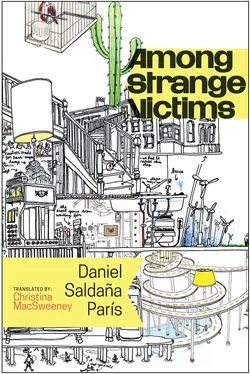Daniel Saldaña París
Among Strange Victims
Daniel and Christina would like to thank the OMI International Arts Center for including them in its Translation Lab residency, which allowed them to work together on the final proofs of Among Strange Victims and to get to know each other better as author and translator.
On park benches
Among strange victims
The poet and amputees come sit together.
ARTHUR CRAVAN
 1
1 
It’s unnecessary to start by describing the actions that make up my routine. That tedious list will come later. First, I’d like to state that my head floats about two inches above the top of my neck, detached from me. From that position, it’s easier for me to observe the irritating texture of the days.
When it rains, I don’t get melancholy. Quite the reverse. I simply have the impression that the weather is, finally, doing justice to the general grayness of existence. Good-bye, tropical hypocrisy; let the sun return to its corner of the galaxy and for once leave us to contemplate the unrelieved darkness that looms over us, sad mortals attired in fake Nike tennis shoes covered in mud.
I sometimes think it would be wonderful to draw diagrams that, rather than the usual preposterous and hyperspecific statistic, represent a dull, everyday state of affairs. Diagrams that tame the seeming disorder of things and help me to place myself among them. For example, a chart with the speeds, accelerations, and even the manias and minor defects of the passersby who file around this fountain. While I watch them from my disintegrating bench at one end of an oval gazebo, I try to imagine those variables, the columns and colors of that chart. The all-powerful statistics will summarize, in perfectly round numbers, the comings and goings of the pigeons. I’m not really sure how, but the fat man who is right now shifting his weight from one foot to the other and has a tiny mobile phone in his hand will be represented. The children running around their parents like small, feverish satellites will appear as relevant data, as will the couples oscillating around the bushes, looking for a patch of shadow in which to lavish indecent displays of affection on each other. In the chart will be the aimless hobbling of the elderly pensioner who, only a few moments ago, looked at me with a mixture of suppressed rage and resignation as if envying the youth of which, from the old man’s point of view, I am not taking full advantage; and the firm gait of the ice cream seller, who knows exactly what the afternoon holds for him, will be there too. The chart will also register, by means of occasional footnotes, the exceptional cases: the sudden stillness of the passersby when a screeching of tires, after a barely perceptible silence, results in a crash; the collective haste of mothers when the first raindrops fall from the sky.
And of course the chart will have a whole column, or a huge portion of its round pie, for a detailed account of my meanderings: if I take three turns around the fountain, the chart will know and represent them in a special, phosphorescent color; if I allow my steps to be guided by the perfume of a woman in a tailored dress, the same will be true; if I decide to stop idling away the time in this gazebo and walk slowly home, dragging my feet along the sidewalk as the four-in-the-afternoon sun begins to lose its strength, as I am now doing, the chart will know it too.
But there is no fanatical god of statistics who amuses himself designing Excel tables on his celestial laptop, paying disproportionate attention to this region of the world, just outside the center of Mexico City, so I have to keep walking and resign myself to the fact that I’m the only person aware of the rhythm of my steps, the only one who knows that I twist my left foot slightly inward and try to cross the digits of my right foot, putting the big toe over the one next to it, a custom thanks to which my foot begins to hurt after a few blocks, and the soles of my shoes always end up splitting in the same place, under the ball of my foot — objects are traitorous. I’m the only person who knows me in such detail, and for that reason I’m the only one who can register this, even if it is only on the ephemeral chalkboard of the memory, for the detail then to disappear, without warning, among thousands of other pieces of data related to the rhythm and cadence of my steps, data no one will ever consult with insatiable curiosity in the immensely vast annals of a virtual library of nonsense. “Statistics doesn’t recognize my true value,” I tell myself, in summary.
Fortunately, as soon as I enter my apartment, those slightly oppressive thoughts disappear at exactly the same moment I press the stop button on my iPod, take off the headphones, and switch on the living room light. In contrast to the bedroom, the living room is always dark, so I have to illuminate it, even at this hour: 4:17 in the afternoon.
The vista that is revealed isn’t particularly beautiful, or perhaps I should say it isn’t canonically beautiful. My furniture is old and each piece is slightly broken in some way, with the exception of a small red coffee table I bought two months ago; the fabric lampshade, hanging from a cable repaired with duct tape that sprouts from a hole in the ceiling, accumulates inexplicable stains that are projected onto the walls like cave paintings. Certain parts of the wall, afflicted with damp, have some sort of blisters of paint that eventually burst and cover the dark blue upholstery of my armchair in fine white powder.
But despite these signs of deterioration, to me my apartment doesn’t seem completely squalid. I have some plants, a small black bookcase holding an encyclopedia of biology — the corner of a page turned down in the fifth volume marks the most exciting chapter: rotifers — and my two windows: the one in the living room, with a view of the interior courtyard of the building, and the one in my bedroom, looking onto a vacant lot. It’s a strange arrangement of space. A sensible architect would have reversed the order, leaving the living room with an external window and the bedroom with a view of the courtyard; but maybe the architect was afraid someone would construct a ghastly, enormous building, with barbed wire everywhere, on that vacant lot, and so left the bedroom window, always less important than the one in the living room — a domestic agora — with that unfulfilled threat. Luckily, the vacant lot is still vacant.
Saturdays all, or almost all, go like this: I wake around nine, idle away the first few hours looking at the vacant lot or pretending — to no one — to read in bed; I prepare a simple breakfast and go out to take a walk around the neighborhood; I have something to eat in the street at lunchtime and, afterwards, I sit on the disintegrating bench in the gazebo to watch the people walking by. At about four o’clock, I go back home to try to do all those things I don’t have time for during the week, things that for five days I swear up and down I’ll get around to on Saturday. I do, in fact, try to do them, but I rarely succeed. Today, for example, with great effort, I’ve managed to organize the bills so that early on Monday morning, before work, I can pay the electricity, telephone, and water. Next Saturday, perhaps, I’ll manage to get someone to come and give me an exact diagnosis of what is happening to my living room walls, even though, as I said, the damp doesn’t particularly bother me. I won’t do this for my own benefit but for potential visitors, the women out there waiting for me to talk to them and invite them up for coffee—“Sorry, I’m out of sugar”—in my living room — the domestic agora, as I said. But to tell the truth, I don’t invite many people into my apartment. In fact, I’ve never invited a woman in, except for once, when a neighbor who doesn’t live here anymore asked if she could use the telephone, and that wasn’t even really an invitation, just, at best, a passive concession.
Читать дальше

 1
1 







